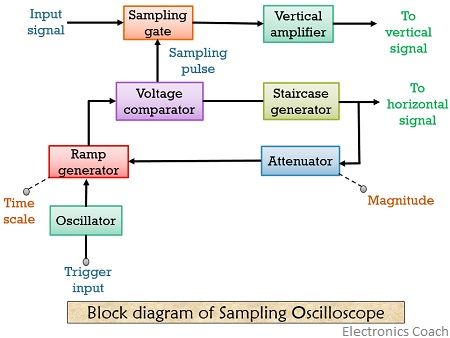Definition: Sampling Oscilloscope is an instrument that is used to generate waveform by collecting various samples of an electrical signal. It is basically an advancement of digital oscilloscope having additional features for special purposes.
It utilizes the principle of Stroboscopic light technique and is used in order to analyse fast electrical signals.
In sampling oscilloscope from various portions of the waveforms, different samples are taken, over consecutive cycles and the overall image is shown on screen as a continuous wave. In order to create a waveform around 1000 points are to be needed.
It is to be noted here that, before getting displayed, the resultant waveform is amplified with the help of a low bandwidth amplifier. These instruments are used to observe high-frequency signal that lies beyond 50 GHz range. A high-frequency waveform is achieved at the output of the oscilloscope as compared to the slope sample rate.
The thing that is needed to keep in mind that a transient waveform could not be displayed by the sampling technique.
Block diagram and Working of Sampling Oscilloscope
The figure below shows the block diagram of the sampling oscilloscope:

Here, as we can see the input signal is fed into the sampling gate. When the sampling pulse is provided to the sampling gate, it gets open in order to sample the input waveform. It is noteworthy that sampling is to be done in synchronization with the frequency of the applied input signal.
The vertical amplifier employed in the circuit delays the input signal and after amplification, the signal is given to the vertical plates.
When the sampling cycle begins, the oscillator gets activated by the trigger pulses. Due to which, linear ramp output voltage is produced. The signal generated from the ramp generator is then fed to the voltage comparator unit.
Here, the ramp signal gets compared with the staircase signal, generated by the staircase generator. During comparison when the amplitude of the two signals is equal, it advances the staircase by one step. Thus generating a sampling pulse. This again opens the sampling gate and the cycle is repeated in a similar manner.
The size of the steps generated by the staircase generator determines the resolution of the image at the output. When the size of the steps is smaller, the number of samples will be larger. Thus, the image resolution will be higher.
The figure below shows the waveforms at the various blocks of the sampling oscilloscope:
The frequency of samples in the Sampling Oscilloscope can be as low as one-hundredth of the input signal frequency. Thus we can say for the input signal frequency of 1 GHz only 10 MHz amplifier bandwidth is needed.
What is delayed sweep in a sampling oscilloscope?
Delayed sweep allows the addition of a certain time interval between trigger point and the start of scope sweep. By the help of this technique, one can look small segment of any waveform. Sometimes, measurement is accomplished only by introducing delaying feature.
Methods of Sampling
In a sampling oscilloscope, there are various methods by which sampling can be done. The methods are as follows:
- Real-time sampling
It is done in order to invade high-frequency samples with accuracy. In this method, the digitizer employed operates at a high speed in order to register most of the points in a single sweep. The high-frequency waveform is so distinct that at any instant the level of current and voltage cannot be correlated with its neighbouring ones.
So, to avoid repetition, it is suggested to register the samples in the time slot of their occurrence. It requires a high-speed memory as the sampling frequency is high.
- Equivalent sampling
In this method of sampling, the digitizer operates at samples that are received from the various repetition of the signal. In such a case, each repeated signal can provide one or more samples. This somehow improves the signal invading accuracy.
It is basically done by 2 methods:
- Sequential method: In this technique, triggering decides the recording rate of the samples. However, each sample is to be recorded with a little delay. At the time of next triggering, another increment in delay is introduced. The cycle thus repeats in such a manner.
- Random sampling method: In this method, triggering does not determine records of the samples instead a clock is employed in the circuit to do so. This means that at regular time interval samples are recorded but that is definitely independent of that of triggering rate.
Advantages of sampling oscilloscope
- It is advantageous using a sampling oscilloscope, as it can measure high-speed electrical signals.
- By using sampling techniques, the input signal can be instantly transformed into a signal in a low-frequency domain. Further circuitry produces a highly efficient display.
- It has the ability to react and store information in the form of rapid bits.
Disadvantage of sampling oscilloscope
- Sampling oscilloscope allows the measurement to be done on signals having repetitive waveforms.
Whenever there is a need to display two waveforms simultaneously, some of the oscilloscopes have different sweep separation control system.
Leave a Reply